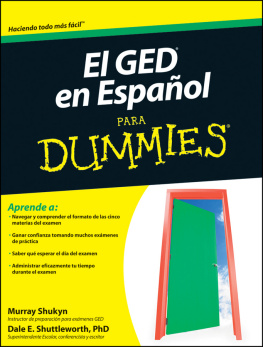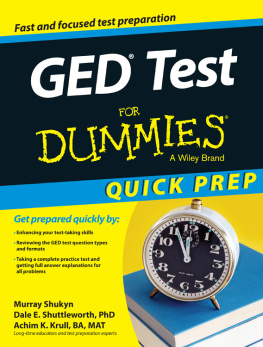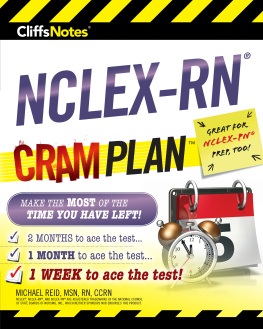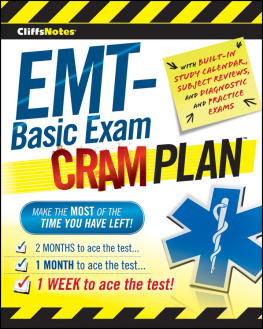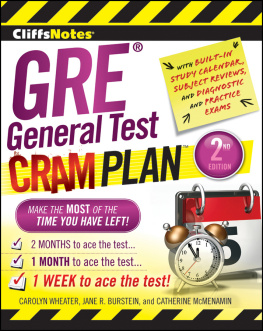
GED

by Murray Shukyn and Dale E. Shuttleworth, Ph.D.

Editorial
Acquisition Editor: Greg Tubach
Project Editor: Elizabeth Kuball
Copy Editor: Elizabeth Kuball
Technical Editors: Tony Bedenikovic, Jane Burstein, Sven Dubie, Scott McDougall, Mary Jane Sterling, and Dario Untama
Composition
Proofreader: Melissa D. Buddendeck
Wiley Publishing, Inc., Composition Services
CliffsNotes GED Cram Plan
Published by:
Wiley Publishing, Inc.
111 River Street
Hoboken, NJ 07030-5774
www.wiley.com
Copyright 2011 Wiley, Hoboken, NJ
Published simultaneously in Canada
Library of Congress Control Number: 2011922784
ISBN: 978-0-470-87478-3 (pbk)ISBN: 978-1-118-01571-1 (ebk)
Printed in the United States of America
10 9 8 7 6 5 4 3 2 1
No part of this publication may be reproduced, stored in a retrieval system, or transmitted in any form or by any means, electronic, mechanical, photocopying, recording, scanning, or otherwise, except as permitted under Sections 107 or 108 of the 1976 United States Copyright Act, without either the prior written permission of the Publisher, or authorization through payment of the appropriate per-copy fee to the Copyright Clearance Center, 222 Rosewood Drive, Danvers, MA 01923, 978-750-8400, fax 978-646-8600, or on the web at www.copyright.com. Requests to the Publisher for permission should be addressed to the Permissions Department, John Wiley & Sons, Inc., 111 River Street, Hoboken, NJ 07030, (201) 748-6011, fax (201) 748-6008, or online at http://www.wiley.com/go/permissions.
The publisher and the author make no representations or warranties with respect to the accuracy or completeness of the contents of this work and specifically disclaim all warranties, including without limitation warranties of fitness for a particular purpose. No warranty may be created or extended by sales or promotional materials. The advice and strategies contained herein may not be suitable for every situation. This work is sold with the understanding that the publisher is not engaged in rendering legal, accounting, or other professional services. If professional assistance is required, the services of a competent professional person should be sought. Neither the publisher nor the author shall be liable for damages arising herefrom. The fact that an organization or Website is referred to in this work as a citation and/or a potential source of further information does not mean that the author or the publisher endorses the information the organization or Website may provide or recommendations it may make. Further, readers should be aware that Internet Websites listed in this work may have changed or disappeared between when this work was written and when it is read.
Trademarks: Wiley, the Wiley Publishing logo, CliffsNotes, the CliffsNotes logo, Cram Plan, Cliffs, CliffsAP, CliffsComplete, CliffsQuickReview, CliffsStudySolver, CliffsTestPrep, CliffsNote-a-Day, cliffsnotes.com, and all related trademarks, logos, and trade dress are trademarks or registered trademarks of John Wiley & Sons, Inc. and/or its affiliates. GED is a registered trademark of the American Council on Education Corporation. All other trademarks are the property of their respective owners. Wiley Publishing, Inc. is not associated with any product or vendor mentioned in this book.
For general information on our other products and services or to obtain technical support, please contact our Customer Care Department within the U.S. at 877-762-2974, outside the U.S. at 317-572-3993, or fax 317-572-4002.
Wiley also publishes its books in a variety of electronic formats. Some content that appears in print may not be available in electronic books. For more information about Wiley products, please visit our web site at www.wiley.com.
Note: If you purchased this book without a cover, you should be aware that this book is stolen property. It was reported as unsold and destroyed to the publisher, and neither the author nor the publisher has received any payment for this stripped book.
About the Authors
Murray Shukyn is Associate Director of the Training Renewal Foundation. He has been a teacher, author, program designer, curriculum designer, and implementer at the elementary, secondary, and university levels. His involvement with GED stretches over a dozen years, and he has tutored, mentored, and assisted students in reaching their goal of passing the GED test.
Dale E. Shuttleworth, Ph.D., is Executive Director of the Training Renewal Foundation. His career as a community educator has included experience as a teacher, school-community worker, consultant, principal, program coordinator, school superintendent, and university course director.
An author of 10 books and 200 articles in journals and periodicals, he has served as an expert consultant for the Organization for Economic Cooperation and Development (OECD) in Paris and is the recipient of the prestigious Dag Hammerskjold Gold Medal for Excellence in Education.
Acknowledgements
We wish to express our appreciation to Marilyn Shuttleworth, who assisted us in the preparation of this manuscript; the Training Renewal Foundation, for the opportunity to work in the world of the GED; and the late Peter Kilburn, former Canadian GED Administrator, for his inspiration, friendship, and encouragement in introducing us to the potential of the GED to be a source of fulfillment and liberation in the lives and careers of so many adult learners who have dropped out of traditional schooling accreditation systems.
Introduction
The GED tests are an opportunity for people who havent finished high school to obtain a certificate from a recognized authority (the American Council on Education), showing that they have the equivalent of a high school diploma. The GED is the only high school equivalency certificate recognized all around the world. A GED certificate is a passport to the world of advancement on the job and an entry into the wonderful world of post-secondary education.
If youre interested in this book, you must have already thought of the advantages of earning a high school equivalency certificate. If you bought this book, youre on your way to taking the tests. The first thing you have to do is determine how long you have to prepare for the GED tests. In many areas of the country, tests are given regularly and you can decide for yourself when you want to take the tests. In some areas, the tests arent given that often, so you have to decide when you need to take the tests. Whether you have one week, one month, or two months to prepare, this book can help you do your best on the GED tests.
About the GED
The GED test challenges your abilities in five main areas, divided into seven sections:
Test Area | Number of Questions | Time Limit |
Language Arts, Writing, Part I | | 75 minutes |
Language Arts, Writing, Part II | 1 essay | 45 minutes |
Social Studies | | 70 minutes |
Science | | 80 minutes |
Language Arts, Reading | | 65 minutes |
|



